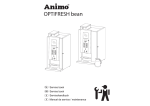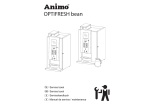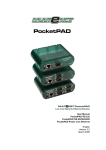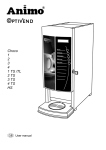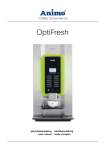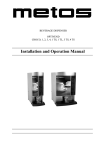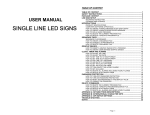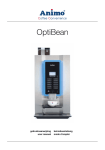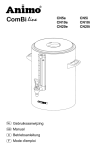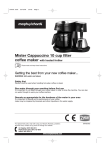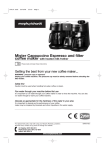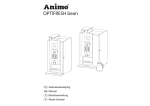Download Animo OptiFresh User manual
Transcript
NL Service boek GB Service book D Servicehandbuch F Manuel de service / maintenance CONTENT PREFACE .....................................................................................................................................44 1. BASIC FUNCTIONING ..........................................................................................................45 1.1 Boiler System...................................................................................................................46 1.2 Temperature regulation ....................................................................................................46 1.3 Hot water dispensing .......................................................................................................46 1.4 Cold water dispensing (optional) .....................................................................................46 1.5 Ingredients and mixer system ..........................................................................................46 1.6 Evaporation extractor system ..........................................................................................47 1.7 Brewer unit.......................................................................................................................47 1.7.1 Adjustment.............................................................................................................48 1.7.2 Setting tips .............................................................................................................49 1.7.3 Troubleshooting .....................................................................................................50 2. MENU STRUCTURE .............................................................................................................51 2.1 The operator/service menu ..............................................................................................51 2.2 The operator menu ..........................................................................................................52 2.3 The service menu ............................................................................................................53 3. RECIPE SETTINGS ...............................................................................................................61 3.1 Quick recipe .....................................................................................................................61 3.2 Model code system ..........................................................................................................61 3.3 Button settings .................................................................................................................62 3.3.1 Standard canister configuration ..............................................................................62 3.3.2 Different canister configuration ...............................................................................63 3.4 Detailed recipe settings ....................................................................................................62 3.5 Timebar recipe settings....................................................................................................62 3.6 Calibrating the hot water valves.......................................................................................64 4. SOFTWARE ..........................................................................................................................65 4.1 Memory card ....................................................................................................................65 4.2 Installing software ............................................................................................................65 4.3 Installing a language ........................................................................................................65 5. SERVICE ..........................................................................................................................96 5.1 Setting a service parameter .............................................................................................66 5.2 Preventative maintenance ...............................................................................................66 5.2.1 Service contracts ...................................................................................................66 5.2.2 Servicing ................................................................................................................67 5.3 Descaling instructions ......................................................................................................68 42 05/2008 Rev. 0.6 6. COMPONENT ACCESSIBILITY ............................................................................................70 6.1 Electronics summary .......................................................................................................71 6.1.1 Control unit ............................................................................................................71 6.1.2 Interface / Display ..................................................................................................72 6.1.3 Power supply .........................................................................................................72 6.2 Main circuit board entrances............................................................................................73 6.3 Main circuit board exits ....................................................................................................74 6.4 Main circuit board communication ...................................................................................75 7. TROUBLESHOOTING ...........................................................................................................75 7.1 Read log ..........................................................................................................................75 7.2 Clear log ..........................................................................................................................75 7.3 Troubleshooting ...............................................................................................................76 8. COIN MECHANISM (OPTIONAL)..........................................................................................78 8.1 Standard configuration.....................................................................................................78 8.2 Rejecting coins ................................................................................................................78 8.3 Activating existing tokens ................................................................................................79 8.4 Programming a new token ...............................................................................................79 8.5 Accepting Euros and Tokens ...........................................................................................79 8.6 accepting Tokens only .....................................................................................................80 8.7 Cleaning the coin holder ..................................................................................................80 05/2008 Rev. 0.6 43 © 2008 Animo® All rights reserved. No part of this document may be reproduced and/or made public in print, microfilm, electronic media or any other form without the manufacturer’s prior consent. This also applies to the corresponding diagrams and/or charts. PREFACE Purpose of this document This document provides directions for use and serves as a service document for trained, authorised service staff to safety install, programme and maintain this device. - Trained, authorised service staff are considered to be those who install, programme and maintain the device, and are able to carry out repairs. The majority of settings, including product settings, are protected by a PIN code. This PIN code ensures that users do not gain access to the service menu. It is recommended not to leave this document with the user after installation and to change the standard factory PIN code. All sections and paragraphs are numbered. The various figures referred to in the text can be found in the figures section at the beginning of the manual or with the corresponding subjects. Pictograms and symbols. CAUTION General indication for: IMPORTANT, CAUTION or REMARK. WARNING Warning for possible damage to the device, surroundings or environment. DANGER Danger of possible severe damage to the device or physical injury. DANGER Danger of electricity and voltage. DANGER Danger of electrostatic discharge (ESD) in electronics. 44 05/2008 Rev. 0.6 1. BASIC FUNCTIONING 1. Waste bin 6. Fresh brew coffee canister 2. Hot water outlet 7. Coffee canister motor 3. Coffee outlet/Drink outlet (instant) 8. Dispensing valves 4. Brewer 9. Water reservoir 5. Brewer motor 10. Inlet valve Fresh brew 7 8 9 10 11 Instant Cold water (optional) 12 6 13 5 14 4 20 21 19 18 16 17 15 3 2 1 Fig. 1 Instant (OptiFresh 2 model and upwards) 11. Instant ingredient canisters 15. Mixer motor 12. Canister motor 16. Mixer impellor 13. Ventilator 17. Mixer housing 14. Evaporation extractor filter cassette 18. Evaporation extractor ring Cold water (optional) 19. Cold water outlet 22. Inlet valve 21. Cooling unit (base cabinet) 05/2008 Rev. 0.6 45 1.1 Boiler System Turn on the device using the ON/OFF switch. The display will light up. The magnetic valve (fig. 1-10) will open and the hot water reservoir (fig. 1-9) will be filled to the maximum electrode. The heating element will be switched on. The display shows [ boiler filling ] and [ boiler heating ]. As soon as the NTC sensor measures the set temperature, the heating element will be switched off. When a drink is being dispensed the water level drops and the maximum electrode is released; the inlet valve (2.5 litres/min.) opens and immediately refills the reservoir until the maximum level is reached again. If the water level falls under the minimum electrode level during operation, the operating panel display will show [refilling boiler]. If the supply of water is not restored within 90 seconds, the display will show the error message [E3 level error] and shut off the inlet valve. 1.2 Temperature regulation The heating element is turned on when the water temperature falls below the temperature setting and the minimum electrode registers water. The temperature in the water reservoir is measured using an NTC precision sensor mounted on the outside wall of the reservoir. The water temperature also drops when drinks are dispensed. To avoid the temperature regulator from responding too late, the heating element is switched on as soon as the inlet valve (fig. 1-10) opens and cold water is added. The heating element switches off again as soon as the inlet valve shuts off. The software can also be used to delay when the heating element switches off. See menu item 2.4 Settings / Temperature in the service menu. The heating element always switches off when the maximum boiler temperature of 97˚C is reached. 1.3 Hot water dispensing When dispensing drinks one of the dispensing valve (fig. 1-8) opens and hot water flows to the brewer or mixer system. The flow velocity for each valve is set using the adjustment screw on the valve. The amount of outflow is determined by the length of time that the valve stays open. In order to rinse the brewer unit and mixer system, a small amount of rinsing water is released shortly after dispensing to rinse away any ingredient residue. 1.4 Cold water dispensing (optional) OptiFresh has a built-in cold water option + special base cabinet with built-in cooling unit. When dispensing a cold-water recipe, inlet valve DV6 opens (fig. 1-21) and allows water to flow from the mains to the cooling unit cooling coil (fig.1-20). The cooled water already present flows directly to the cold water outlet (fig. 1-19). As soon as the valve shuts off again the cold water dispenser stops immediately. 1.5 Ingredients and mixer system The ingredients canisters (fig. 1-11) are powered by a 130RPM motor (fig. 1-12). The instant product (ingredient) is forced out of the canister by a coil and drops through the dispensing bent pipes into the mixer unit (fig. 1-17). At the same time, the dispensing valves (fig. 1-18) dispense hot water into the mixer unit. The mixer motor (fig. 1-15) blends the instant product with water at a speed of 10,700 RPM using the mixer rotor (fig. 1-16). The drink flows into the cup via the drink outlet (fig. 1-3). All individual parts mentioned in this section can be sequentially coordinated using adjustable parameters (timers) in the control unit. 46 05/2008 Rev. 0.6 1.6 Evaporation extractor system Evaporation released during mixing is largely absorbed by the evaporation extractor ring (fig. 1-18) and sucked into the machine via the filter cassette (fig. 1-14). The evaporation and ingredient residue are absorbed by the filter. The filter (fig. 1-14) can be easily reached (for cleaning purposes) by dismantling the mixer unit (fig. 1-17). To a large extent, this prevents evaporation from entering the canister outlet and making ingredients damp. 1.7 Brewer unit Ground coffee and hot water are dispensed to the permanent filter and are drawn into the filter by vacuum. After making a fresh brew drink selection the following process (fig. 2) starts: Start position Brewer in resting position. Start brewer 3 The piston moves down and sucks the coffee extract through the permanent filter. Start brewer 1 The piston leaves the resting position. Ground coffee and hot water is dispensed to the brewer unit. Pause 3 Just before the coffee extract leaves the brewer the piston either pauses or stops again to make sure the coffee residue is sufficiently dry. Pause 1 The piston stops just above the outlet. Coffee and hot water is still dispensed. Start brewer 4 The piston moves down further so that the outlet opening opens. Start brewer 2 The piston rises and forces air upwards out of the cylinder, ensuring that coffee and water are mixed thoroughly. Water dispensing stops during this cycle. Pause 4 The coffee is now dispensed to the cup, goblet or jug. Pause 2 Piston stops at the highest setting to enable the coffee to be extracted. Return to start The piston returns to the start position again. At the same time the coffee residue is wiped away by the filter wiper, before it drops into the waste bin. 1,3 sec. 6,2 sec. start position Start 1 1 sec. 3,8 sec. 2,5 sec. retrun to start Pauze 4 Pauze 3 Pauze 2 3,5 sec. 6 sec. Start 4 Start 3 Start 2 Pauze 1 3 sec. 4 sec. 2 sec. Fig. 2 05/2008 Rev. 0.6 47 1.7.1 Adjustment If a leak occurs between the brewer unit and the permanent filter the tensile force of the brewer needs to be increased. The tensile force of the brewer should be set so that no water is able to leak between the brewer unit (fig. 3-1) and the permanent filter (fig. 3-3). The tensile force also ensures that the wiper (fig. 3-4) completely pushes the coffee residue off of the permanent filter. 1 See figure 3 for the most important brewer parts: 2 1. Brewer unit 2. Rubber seal (Art. No. 03375) 3. Permanent filter (Art. No. 03374) 4. Wiper (Art. No. 03380) 5. Tension member 6. Adjustment shim* 7. Rubber 8. H-frame 9. Tension member adjustment 3 4 (Art. No. 03384) 5 6 1. First remove the brewer from the device (see section 8.7.2 for instructions). 2. The tensile force can be set by adding adjustment shims (fig. 3-6) between the tension member (fig. 3-5) and the H-frame (fig. 3-8). 3. Press the H-frame downwards and take the tension member out of the recess. Place an adjustment shim* in the recess and replace the tension member. CAUTION: adding multiple shims at the same time can cause excess tensile force and damage the brewer! 7 8 9 4. In most cases this procedure is sufficient for repairing leaks. If the brewer unit still leaks fit another adjustment shim. 5. If the brewer unit still leaks remove the two adjustment shims and then turn in the tension member once (clockwise). CAUTION: turning in the tension member should only be done as a last resort. Fig. 3 * a extra shim is located behind the stainless steel panel on the inside of the door. 6. If the tensile force is correct but the brewer still leaks do not increase the tensile force any more! For further help see chapter 1.7.3 Troubleshooting. 48 05/2008 Rev. 0.6 1.7.2 Setting tips Tensile force too low (fig. 4) Tensile force correct (fig. 5) Tensile force too high (fig. 6) If the wiper moves over the upper side of the cylinder it makes no If the brewer is adjusted correctly, the wiper moves carefully over the upper side of the cylinder and pushes the coffee residue off of the permanent filter. The wiper bends slightly. If the brewer is adjusted too high, the wiper will stretch and become clearly warped. Glancing along the long side of the wiper will show a warped effect in the rubber. When the wiper moves to the right the coffee residue is transported to the waste bin. The coffee residue drops from the right side of the brewer straight into the waste bin. The brewer is under extreme pressure and the sound of the brewer motor audibly changes as a sign of the severe load. This may even damage the wiper! Fig. 5 Fig. 6 contact with the permanent filter, so that coffee residue is left on the filter. The wiper does not bend at all. If the brewer unit is adjusted in this way it can leak. If leakage is severe this can even result in a vacuum loss, which means that the coffee residue remains too wet (particularly for larger dispensing volumes). Fig. 4 During the complete brewer cycle, ball bearings from the wiper arms and the tension member are under severe pressure, resulting in bending. The ball bearings may then break away, cracking the plastic brewer housing. Signs that the tensile force is too high (fig. 6): • The wiper is severely bent when it slides across the upper side of the brewer cylinder and permanent filter. • It appears as if the wiper arm is flattened between the brewer unit and the upper side of the brewer cylinder. • The brewer motor sounds as though it is running under extreme pressure. • The wiper pushes against the coffee residue when moving to the left. • Accumulation of coffee residue round the waste bin. 05/2008 Rev. 0.6 49 1.7.3 Troubleshooting Problem Probable cause Action The wiper pushes against the coffee residue when moving to the left. The brewer unit does not rise far enough. Check if the brewer unit is able to move upwards freely. The brewer unit is hindered during the upward movement. The brewer unit tensile force is too high. Remove one adjustment shim to reduce the tensile force. The coffee residue remains too wet. There is inadequate suction in the coffee residue. Increase the pause 3 time (see section 1.6) Never increase the tensile force under if the brewer unit tensile force is set correctly. The water temperature is too high. Lower the water temperature. The permanent filter is dirty or worn. Clean or replace the permanent filter. If the above-mentioned problem is not resolved: Check the brewer unit and cylinders for fractures. Replace the defective parts. Check the cylinder for wear and tear or scratches. Replace the defective parts. Check the Teflon coating for wear and tear. Replace the defective parts. 50 05/2008 Rev. 0.6 2. MENU STRUCTURE 2.1 The operator/service menu The majority of settings, including product settings, are protected by a PIN code. This PIN code ensures that users do not gain access to the service menu. It is recommended not to leave this document with the user after installation and to change the standard factory PIN code. This section describes how the various settings can be changed by trained, authorized service staff. You can read about how to gain access to the service menu below. On access to the service menu the control panel has the following functions: Escape (return without making any changes) Previous (menu item / increase value) Next (menu item / decrease value) Enter (accept menu option) Summary: 05/2008 Rev. 0.6 Operator menu Service menu 1.0 Free dispensing 2.1 Quick recipe 1.1 Clock 2.2 Button settings 1.2 Timer settings 2.3 Recipe settings 1.3 Recipe counters 2.4 Settings 1.4 Quick recipe 2.5 Reset counters 1.5 Permanent filter 2.6 Descale / filter 1.6 Software 2.7 Hardware test 1.7 PIN-code 2.8 Read log 2.9 Clear log 2.10 Load defaults 2.11 SD menu 2.12 Change PIN code 2.13 Additional settings 51 Fig. 7 2.2 The operator menu Operator menu Main item Sub item Item 1.0 Free dispensing 1.1 Clock 1.2 Timer 1.3 Recipe counters Range Set Description Yes/no Yes Set the device to free or paid dispensing here. Time HH:MM Set the clock to the correct local time here. Date DD-MM-JJJJ Set the clock to the correct local time here. Mon-Fri On Off 00:00 00:00 Sat On Off 00:00 00:00 Set the time when the device should operate here. If the timer switches off the device it will automatically revert to standby mode. Sun On Off 00:00 00:00 Total Off 00:00 Free Cups Number of free dispensed drinks (recipe 1) Paid Cups Number of paid dispensed drinks (recipe 1) Jug Cups Number of dispensed jugs (recipe 1) Total Cups Total counter for all dispensed recipes Free Cups Total counter for all free dispensed recipes Paid Cups Total counter for all paid dispensed recipes Jug Cups Total counter for all dispensed jugs Recipe 1 Recipe 12 Recipes total Rinse counters Total counter for recipe 1 (free-paid-jugs) Brewer Number of brewer rinses Mixer(s) Number of mixer rinses Reset counters 1.4 Quick recipe Recipe name 1 Recipe name 12 1.5 Permanent filter Total rest of all counters Cup volume 50-200 ml 120ml Coffee (1) -20 / +20% 0% Decaf (2) -20 / +20% 0% Chocolate (3) -20 / +20% 0% Topping (4) -20 / +20% 0% Sugar (5) -20 / +20% 0% Reset teller After the permanent filter of the vending unit (brewer) has reached the maximum number of brews the filter must be replaced. After replacing the permanent filter, reset the ‘replace brewer filter’ indicator. 1.6 Software 1.7 PIN-code Use this for setting the volume and strength of coffee, milk, sugar and cocoa easily per recipe (drink button). Only the ingredients applicable to the recipe are shown. Software version is readable here. 2-2-2-2-2 52 PIN code = press the number 2 key five times. 05/2008 Rev. 0.6 2.3 The service menu Service menu Main item Sub item Item Range Set Description 2.1 Quick recipe Recipe name 1 Cup volume 50-200 ml 120ml Coffee (1) -20 / +20% 0% Decaf (2) -20 / +20% 0% Use this for setting the volume and strength of coffee, milk, sugar and cocoa easily per recipe (drink key). Only the ingredients applicable to the recipe are shown. Chocolate (3) -20 / +20% 0% Topping (4) -20 / +20% 0% Sugar (5) -20 / +20% 0% <Recipe name> Recipe list See section 3.2 Recipe active Yes/no Yes Use this to place the product concerned out of service. Price 0,05-2,00 0,10 For paid dispensing a price can be set here for each product button. Cup volume 50-230ml * 120ml Set the desired cup volume here. All other parameters (e.g. coffee dosage) can be adjusted automatically. This parameter is coupled to the quick recipe cup volume! Recipe name 12 2.2 Button setting Button 1 Change any recipe buttons here that standard factory settings. All settings that correspond to selected recipes are automatically loaded. * From software 2.0 Cup volume >200ml advice: deactivate Quick recipe in the Operator menu; 2.4 Settings / I/O Quick recipe. Cup volume >200ml change brewer parameters (from software V02.01): Pause 2 increase to 4,5 s. (2,5) Start 3 increase to 4,8 s. (4,0) Pause 3 increase to 5,5 s. (1,5) Start 4 decrease to 2,2 s. (3,0) Pause 4 increase to 4,0 s. (2,0) Multicup 0-20 0 Set the number of cups that should be dispensed when the key switch is in the jug setting. Key switch 0-1-2-3 0/1 Recipe button concerned works as follows: 0= key switch setting n/a CUP (paid) or JUG* (paid) 1= key switch |: CUP (paid) key switch –: JUG* (paid) 2= key switch |: no dispensing key switch –: JUG* (paid) 3= key switch |: CUP (paid) key switch –: JUG* (free) (*when multicup is set to >1) Push & Hold Yes-No No If set to yes: pressing this button starts the hot/cold water dispensing and releasing it stops the hot water dispensing. Only use this option for Water 4 and Water 6 in combination with a hot/cold water recipe button. Drip time 0-10 sec. 2 sec. The length of time that the product continues to run from the brewer or mixer. After this time has elapsed a new drink selection can be made. Button 12 05/2008 Rev. 0.6 53 Service menu continued …. Main item Sub item Sub Item Range Description 2.3 Recipe setting Recipe name 1 Unit 1 DV 1 WT 0,0-30,0 s Waiting time Water 1 DV 1 0,0-100,0 ml Dispensing amount Water 1 (Brewer) Rinse 1 WT 0,0-20,0 s Waiting time Rinsing Water 1 Rinse 1 0,0-15,0 ml Dispensing amount Rinsing Water 1 Automatically deducted from Water 1 Ingredient 1 WT 0,0-30,0 s Waiting time Ingredient 1 Ingredient 1 0,0-50,0 s Product dispensing time Ingredient 1 Ingredient 2 WT 0,0-30,0 s Waiting time Ingredient 2 Ingredient 2 0,0-50,0 s Product dispensing time Ingredient 2 Start brewer 0,0-30,0 s 1st start time brewer Pause 1 brewer 0,0-30,0 s 1st pause time brewer Start 2 brewer 0,0-30,0 s 2nd start time brewer Pause 2 brewer 0,0-30,0 s 2nd pause time brewer Start 3 brewer 0,0-30,0 s 3rd start time brewer Pause 3 brewer 0,0-30,0 s 3rd pause time brewer Start 4 brewer 0,0-30,0 s 4th start time brewer Pause 4 brewer 0,0-30,0 s 4th pause time brewer DV 2 WT 0,0-30,0 s Waiting time Water 2 DV 2 0,0-100,0 ml Dispensing amount Water 2 Rinse 2 WT 0,0-20,0 s Waiting time Rinsing Water 2 Rinse 2 0,0-15,0 ml Dispensing amount Rinsing Water 2 Automatically deducted from Water 2 Ingredient 3 WT 0,0-30,0 s Waiting time Ingredient 3 Ingredient 3 0,0-50,0 s Product dispensing time Ingredient 3 Ingredient 4 WT 0,0-30,0 s Waiting time Ingredient 4 Ingredient 4 0,0-50,0 s Product dispensing time Ingredient 4 Mixer 2 WT 0,0-30,0 s Waiting time Mixer 2 Mixer 2 0,0-50,0 s Mixing time Mixer 2 DV 3 WT 0,0-30,0 s Waiting time Water 3 DV 3 0-100 ml Dispensing amount Water 3 Rinse 3 WT 0,0-20,0 s Waiting time Rinsing Water 3 Rinse 3 0,0-15,0 ml Dispensing time Rinsing Water 3 Automatically deducted from Water 3 Ingredient 5 WT 0,0-30,0 s Waiting time Ingredient 5 Ingredient 5 0,0-50,0 s Product dispensing time Ingredient 5 Ingredient 6 WT 0,0-30,0 s Waiting time Ingredient 6 (optional) Ingredient 6 0,0-50,0 s Product dispensing time Ingredient 6 (optional) Mixer 3 WT 0,0-30,0 s Waiting time Mixer 3 Mixer 3 0,0-50,0 s Mixing time Mixer 3 Unit 2 Unit 3 Recipe name 12 54 05/2008 Rev. 0.6 Service menu continued …. Main item Sub item Sub 2.3 Recipe setting (continued…) Recipe name 1 Item Range Description DV 4 WT 0,0-30,0 s Waiting time Water 4 DV 4 0,0-100,0 ml Dispensing amount Water 4 (Hot water dispensed) DV 5 WT 0,0-30,0 s Waiting time Water 5 DV 5 0,0-100,0 ml Dispensing amount from an extra hot water valve Water 5 (reserved for a Brewer By-Pass option). DV 6 WT 0,0-30,0 s Waiting time Water 6 DV 6 0,0-100,0 ml Dispensing amount from an extra inlet valve Water 6 (Cold Water option) Strength Coffee 0-50% Strength Decaf 0-50% Strength Chocolate 0-50% Strength Topping 0-50% Strength Sugar 0-50% Use the strength setting item to add an ingredient to the strength adjustment. Ingredient strength adjustment: 0= off / > 1 = on Example: [coffee] 20% Strength -0 + ++ -20% -10% 0 10% 20% Example: [cocoa] 40% 0-50% Recipe name 12 05/2008 Rev. 0.6 Strength -0 + ++ -40% -20% 0 20% 40% Strength Ingrediënt 6 Option 55 Service menu continued… Main item Sub item Item 2.4 Settings Language English Range Setting Description Language choice display. Ex factory setting English. Dutch German French Temperature Temp. boiler 95°C * Boiler temperature standard model 1A - 5A 90°C * Boiler temperature FreshBrew + instant model 6A t/m 9A 70-97°C * * From software 2.0 Hysteresis 0-10°C 2°C Temperature drop, after which boiler must reheat Output block 70-95°C 78°C Boiler temperature disables dispensing. Display: [Out of order, boiler heating] Output release 70-95°C 85°C Boiler temperature allows dispensing again Stand-by 60-95°C 60°C Boiler temperature during stand-by Extended Heating 0-5 sec 1 sec To maintain the optimum boiler temperature the heating element and inlet valve switch on simultaneously. Set the waste delay of the element here after the inlet valve is closed. Inlet valve Heating Inlet valve Heating Display Show clock Yes/no No Show clock in display Show date Yes/no No Show date in display Yes/no No Show message text (running text) in display. Only shown if Display Date, Clock or both are set to no. Message text only programmable using a future PC programme. Use bleeper Yes/no Yes Sound signal on or off Fan time 0-300 sec. 60 s. Duration of Fan speed 1 after dispensing Fan speed 1 40-100% 50% Fan speed when resting Fan speed 2 70-100% 100% Fan speed during dispensing Message text 56 05/2008 Rev. 0.6 Service menu continued ….. Main item Sub item Item 2.4 Settings (continued…) Coin system G13 Range Setting 0-100,00 + Token € 0,05 € 0,10 € 0,20 € 0,50 € 1,00 € 2,00 Single vend ja-nee ja Yes: any excess credit is not retained for next drink. No: credit retained for next drink. Max coin accep. € 0,05100,00 € 1,00 Coins larger than € 1.00 are rejected and ejected through the return slot of the coin mechanism. Adjust to the highest recipe product price. Point position 0-2 2 Decimal position in amount Show credit Yes/no Yes Show credit on the display Coin channel 1 Coin channel 6 MDB I/0 Reset counter I/0 Quick recipe * From software 2.0 * Drip tray sign. 2.5 Reset counters Rinse counters Recipe counters Description Coin value setting for each channel. €0.05-€2 respectively. 0.00=free TOKEN=coffee token No MDB software available yet Yes/no No Add Reset counters menu item to the operator menu Yes/no Yes Add Quick recipe menu item to the operator menu Yes/no Yes Turns off drip tray sensor software. Brewer counter? Reset brewer spoelteller Mixer counter? Reset mixer spoelteller Recipe counter 1 Reset recepttellers per recept. Recipe counter 12 Reset counter total Reset totaal tellers Reset all counters 2.6 Descale/filter Service moment Reset alle tellers ineens 0-25000 Service counter Reset serv. coun 05/2008 Rev. 0.6 12500 After the Service Due setting has been reached the Descale/filter indicator will be displayed. See section 5. Service ????? The number of beverages dispensed is counted here. Check here to see how far the machine is from periodic maintenance (descaling boiler or replacing water filter). After periodic maintenance has been carried out (boiler descaled or filter replaced) the service counter should be set to nil. 57 Service menu continued…. Main item Sub item Sub Range Description 2.7 Hardware test Inputs Temperature Boiler temp Level sensors High Low Yes/no Yes/no Drip tray sensor Yes/no Waste bin Yes/no Door switch Yes/no Brewer switch Yes/no Key switch Yes/no Shows the status of the sensors/switches indicated Outputs KW1 Inlet valve (Boiler) Test by holding in recipe button 11. DV1 Dispenser valve 1 (Brewer) DV2 Dispenser valve 2 (Mixer 2) DV3 # During test the display shows the Nominal current (mA) When the Nominal current of a output rises above the set current * mentioned output will be shut off. Caution: BM 1 goes through a complete drinks cycle. * 400 mA Dispenser valve 3 (Mixer 3) DV4 Dispenser valve 4 (Hot water) DV5 Dispenser valve 5 (n/a) DV6 Inlet valve 6 (Cold water) optional! IM1 # Ingredients motor 1 (Canister 1) IM2 # Ingredients motor 2 (Canister 2) IM3 # Ingredients motor 3 (Canister 3) * 400 mA IM4 # Ingredients motor 4 (Canister 4) IM5 # Ingredients motor 5 (Canister 5) IM6 # Ingredients motor 6 (Canister 6) BM/MM1 # Brewer motor MM2 # * 800 mA MM3 # Mixer motor 2 Mixer motor 3 Ventilator * 200 mA LED’s Ventilator LED’s Calib. valves DV1 15 ml / sec Calibrate to 150 ml (10 sec x 15 ml) Test by holding in recipe button 11 (for 1 sec.) to open the relevant valve for 10 seconds. DV2 15 ml / sec Calibrate to 150 ml (10 sec x 15 ml) DV3 15 ml / sec Calibrate to 150 ml (10 sec x 15 ml) DV4 20 ml / sec Calibrate to 200 ml (10 sec x 20 ml) DV5 20ml / sec. Calibrate to 200ml (10sec. x 20ml) (Optional valve for Brewer By-pass) DV6 42 ml / sec Inlet valve cannot be calibrated (fixed flow) 58 05/2008 Rev. 0.6 Service menu continued…. Main item Sub item Item 2.8 Read log Description Saves last 20 error messages, including date and time 2.9 Clear log Are you sure? 2.10 Load defaults Model # OF1A xx00 OF2A xx00 OF3A xx00 OF4A xx00 OF5A xx00 * OF6A xx00 * OF7A xx00 * OF8A xx00 * OF9A xx00 * Are you sure? When a new circuit board is introduced it is necessary to load defaults. When loading defaults it must be stated on the OptiFresh model plate. The correct model settings are not loaded until the question ‘Are you sure?’ has been confirmed. Attention: ● Before you start changing the button- and/or receipt- settings, first close the service menu, only after re-entering the service menu the new model settings will be activated. ● When you confirm this setting all loaded factory settings and changed programmed values will be lost. ● After loading defaults the PIN code reverts to 2-2-2-2-2 and the language reverts to English. Change if necessary. Load data Pers. settings This menu item is for loading personal settings to the device using an SD memory card. This file contains the (amended) personal settings for menus: 2.4 Settings / 2/6 Descale-filter / 2.13 Additional settings. The data file (Ofxxxx00.mdu) should be on the SD card. Language This menu item is for loading a different language set to the device. The data file (xxxxxx.tlf) should be on the SD card. Recipe This menu item is for loading personal recipes to the device using an SD memory card. This file contains the (amended) personal recipes for menus: 2.1 Quick recipe / 2.2 Button settings / 2.3 Recipe settings. The data file (OFxxxx00.rcu) should be on the SD card. Pers. settings This menu item is for saving personal settings to an SD memory card and copying them to another device. All settings amended in menus: 2.4 Settings / 2.6 Descale-filter / 2.13 Additional settings are loaded to the SD card in one data file (OFxxxx00.mdu). Recipes This menu item is for saving personal recipes to an SD memory card and copying them to another device. All settings amended in menus: 2.1 Quick recipe / 2.2 Button settings/ 2.3 Recipe settings are loaded to the SD card in one data file (OFxxxx00.rcu). Repeat PIN code This menu item is for changing the PIN code using buttons 1-4 only. The entire service menu is accessed with this PIN code, which prevents unintentional changes from being made to the machine settings by untrained staff. # See chapter 3.2 Model code system * available from software version 2.0 2.11 SD menu Before saving or loading data, insert an empty SD memory card into the card reader . Memory Card This is located behind the stainless steel panel on the inside of the door. SD card specifications: Clears log Save data - 16MB or greater - FAT16 format Memory Card 2.12 Change PIN New PIN code • The ex-factory PIN code is 2-2-2-2-2 PIN code forgotten or needs to be deactivated? The PIN code input display (operator menu item 1.7) shows a number on the right. Enter the corresponding PIN code (see list on p.60) to access the service menu. 05/2008 Rev. 0.6 59 Service menu continued… Main item Sub item 2.13 Addit. settings Waste manag. From software 2.0 moved to menu 2.4.10 Item Range Cup amount 0-1000 250 Almost full sign. 0-1000 230 After reaching the set total of brewer movements, the display reads: Waste bin almost full Time-out reset 0-50 sec. 15 s The length of time that the waste bin is allowed to be removed (for emptying). When replacing it the (internal) waste bin counter is reset. Any display messages disappear. Waste bin sign.. Yes/no Yes Turns off waste bin sensor software (bypass). Yes/no Yes Turns off drip tray sensor software. Cycle counter xxxxx 0-99999 This Cycle counter records the number of vends the brewer has made. Tip: This counter can be reset after maintenance if the brewer has been checked. Reset counter? Perm.filter coun Reset p. filter Description After reaching the set total of brewer movements, dispensing is disabled and the display reads: Out of order – Waste bin full Drip tray sign. Reset c. counter Set xxxxx Reset Cycle counter (Brewer) 0-10.000 6000 When the set number of (Brewer) vends is reached the display reads ‘Replace permanent filter’ when switching on. Reset counter? PIN Code Table Reset the permanent filter counter after (preventative) replacement No. Table 1 Pincode Table 2 Pincode 1 3 4 2 4 2 11 1 3 3 3 2 2 3 1 4 3 4 12 1 2 4 1 3 3 4 1 3 4 3 13 4 3 1 2 1 4 4 3 2 3 2 14 1 1 1 4 2 5 2 3 3 4 1 15 2 1 2 1 1 6 4 2 1 3 1 16 1 2 2 3 3 7 2 4 2 4 4 17 3 4 1 4 4 8 2 3 2 4 1 18 4 1 4 3 3 9 2 4 3 2 3 19 3 1 2 4 1 10 3 1 3 3 2 20 2 2 3 2 4 Water Quality Water Hardness Table No. Hardness Limescale Indicator ...cups °D °F mmol/l mgCaCo3/l Very hard 18-30 32-55 3,2-5,3 321- 536 5000 Hard 12-18 22-32 2,2-3,2 214-321 8500 Average 8-12 15-22 1,4-2,2 268-214 12.500* Soft 4-8 7-15 0,7-1,4 72-268 20.500 Very soft 0-4 0-7 0- 0,7 0-72 0 = off 60 05/2008 Rev. 0.6 3. RECIPE SETTINGS 3.1 Quick recipe First of all we would like to remind you that the cup volume (ml) and strength (%) can easily be set in the service menu 2.1 Quick recipe (page 53 of this document). The operator of the device (end user) also has access to this quick recipe, which is found under section 1.4 Quick recipe (see user manual). As supplier of the device, you can remove the quick recipe from the operator menu if desired. Go to 2.4 Settings / 2.4.9 I/0 Quick recipe via the service menu and change Yes into No. 3.2 Model code system The OptiFresh models have the following standard canister configurations (fig. 8): 1 1 1 3 3 1 4 3 4 5 Fig. 8 OptiFresh 1 A OptiFresh 2 A OptiFresh 3 A [FB Coffee] [FB Coffee / Chocolate] [FB Coffee / Chocolate / Topping] OptiFresh 4 A [FB Coffee / Chocolate / Topping / Sugar] If the device is delivered with a different canister configuration this can be given a new number using the model code system below. OptiFresh O F 4 A aa00 Model Internal data OF 1 standard 1 OF 2 standard 2 OF 3 standard 3 A Base execution OF 4 standard 4 D Decaf execution OF 2 Topping instead of Chocolate 5 OF 2 Instant Coffee instead of Chocolate 6 OF 3 Instant Coffee instead of Chocolate 7 OF 3 Instant Coffee instead of Topping 8 OF 4 Instant Coffee instead of Sugar 9 05/2008 Rev. 0.6 Model version 61 3.3 Button settings 3.3.1 Standard canister configuration The standard of programmed recipes (table 3) can easily be transferred over the 12 recipe buttons. See service menu 2.2 Button settings (page 53). Optional recipes Standard recipes The optional recipes table are already contained in the software and can easily be programmed under one recipe button. See service menu 2.2 Button settings (page 53). OptiFresh 1 OptiFresh 2 OptiFresh 3 OptiFresh 4 Button Model 1 A Model 2 A Model 3 A Model 4 A 1 # Coffee # Coffee # Coffee # Coffee 2 Espresso Espresso Coffee Milk Coffee Milk 3 Double Espresso Double Espresso Espresso Sugar 4 - Hot Chocolate Double Espresso Milk & Sugar 5 - Coffee Choc Hot Chocolate Espresso 6 - - Coffee Choc Double Espresso 7 - - Cappuccino Hot Chocolate 8 - - Moccacino Coffee Choc 9 - - - Cappuccino 10 - - - Moccacino 11 - - - - 12 # Hot water # Hot water # Hot water # Hot water Cold Water * Cold Water * Cold Water * Cold Water * Jug of Coffee Espresso Choc Latte Macchiato Latte Macchiato Jug of Hot Water Jug of Coffee Espresso Choc Cappuccino Sugar Jug of Hot Water Chocolate Milk Espresso Choc Warm Milk Espresso Sugar Café au Lait Chocolate Milk Jug of Coffee Warm Milk Jug of Hot Water Café au Lait Jug of Coffee # = jug filled using key switch Jug of Hot Water * = only OptiFresh with cold water option Table 3 62 05/2008 Rev. 0.6 3.3.2 Different canister configuration* The standard of programmed recipes (table 4) can easily be transferred over the 12 recipe buttons. See service menu 2.2 Button settings (page 53). The optional recipes table are already contained in the software and can easily be programmed under one recipe button. See service menu 2.2 Button settings (page 53). * Available from software version 2.0 OptiFresh 3 OptiFresh 4 Button Model 5 A Model 6 A Model 7 A Model 8 A Model 9 A 1 # Coffee # Coffee # Coffee # Coffee # Coffee 2 Coffee Milk Espresso Coffee Milk Espresso Coffee Milk 3 Espresso Double Espresso Espresso Double Espresso Espresso 4 Double Espresso - Double Espresso Hot Chocolate Hot Chocolate 5 Cappuccino - Cappuccino Coffee Choc Coffee Choc 6 Café au Lait - Café au Lait - Cappuccino 7 Latte Macchiato Coffee inst. Coffee inst. Coffee inst. Coffee inst. Espresso inst. Coffee inst. Mlk Espresso inst. Coffee inst. Milk 8 9 - Dub. Espresso inst. Espresso inst. Dub. Espresso inst. Espresso inst. 10 - - Dub. Espresso inst. - Moccacino inst. 11 - - Cappuccino inst. - Cappuccino inst. 12 # Hot water # Hot water # Hot water # Hot water # Hot water Cold Water * Cold Water * Cold Water * Cold Water * Cold Water * Warm Milk Jug of Coffee Latte Macchiato Espresso Choc Latte Macchiato Jug of Coffee Jug of Coffee inst. Warm Milk Jug of Coffee Espresso Choc Jug of Hot Water Jug of Hot Water Café au Lait inst. Jug of Coffee inst. Chocolate Milk Jug of Coffee Jug of Hot Water Warm Milk Optional recipes Standard recipes OptiFresh 2 Jug of Coffee inst. Café au Lait Jug of Hot Water Moccacino Café au Lait inst. Latte Macchiato inst # = jug filled using key switch Jug of Coffee * = only OptiFresh with cold water option Jug of Coffee inst. inst. = Recipe made with instant coffee Jug of Hot Water Table 4 05/2008 Rev. 0.6 63 3.4 Detailed recipe settings To change detailed recipe settings (service menu 2.3) you first need to be aware of the various parts such as valves, brewer motor, ingredients motor and mixers that work together. See section 3.5 Timebar recipe settings. The following rules should be taken into consideration: ● Water (valves) are easily set in millilitres. ● Motor running times (Ingredients/Mixers/Brewer) are set in seconds (0.1 second steps) ● All parameters (Water and Ingredients) are based on a 100 ml drink and the programme automatically converts them to the cup volume as set in 1.4 / 2.1 Quick recipe and 2.2 Button settings. ● If a drink contains DV1 and DV2, the total amount of water should always be 100 ml when combined. For DV1, DV2 and DV3, this amount = > 100 ml. ● A Rinse parameter is used to ensure that the brewer unit and mixers are properly rinsed after making a drink. After the mixers are almost empty a small amount of hot water is dispensed to the mixer so that it is as clean as possible on completion. A realistic rinse value is 7.5 ml. Caution: this does not need to be deducted from the amount of water as the programme does this automatically! Example: Set parameter for DV1 = 100 ml, Rinse 1 = 7.5 ml --> Programme carries out the following action: DV1 = 92.5 ml, Rinse 1 = 7.5 3.5 Timebar recipe settings OptiFresh 1 DV 1WT DV 1 Rinse 1 WT Rinse 1 OptiFresh 2 15ml/sec. Unit 2 Unit 1 Unit 1 Ingr. WT Ingredient 1 Ingr. WT Ingredient 2 3 1 Start1 Pause1 Start2 Pause2 Start3 Pause3 Start4 Pause4 DV 2 DV 1 DV 2 WT Unit 2 DV 2 Rinse 2 WT Ingr. WT Ingredient 3 Ingr. WT Ingredient 4 Mixer WT Rinse 2 15ml/sec. Brewer Mixer 2 Hot DV 4 Cold DV 6 Mixer 2 OptiFresh 3 DV 3 WT Unit 3 DV 3 Rinse 3 WT Rinse 3 Ingr. WT Ingredient 5 Ingr. WT Ingredient 6 15ml/sec. OptiFresh 4 Unit 2 Unit 1 3 1 Mixer WT Unit 3 4 5 Mixer 3 DV 1 DV 4 WT DV 4 20ml/sec. (Hot water) DV 5 WT DV 5 20ml/sec. (By-pass option brewer DV 6 WT DV 6 42ml/sec. (Cold water option) 64 Brewer Fig. 9 DV 2 DV 3 Mixer 2 Mixer 3 Hot DV 4 Cold DV 6 Fig. 10 05/2008 Rev. 0.6 3.6 Calibrating the hot water valves The Brewer and Mixers are supplied with water by the Dispensing Valves (DV). In the unlikely event that one of the valves needs replacing, it should be calibrated to one of the dispensing speeds given in figure 11 after it has been fitted. When calibrating valves, use the special Valve Calibration menu by opening the Service Menu and going to 2.7 Hardware Test / 2.7.2 Calibrating Valves. The hot water dispensing valves are accessible by dismantling the canister plateau behind the ingredients canisters. DV 1 = 15ml/sec. (Brewer) DV 4 = 20ml/sec. (Hot water) DV 2 = 15ml/sec. (Mixer 2) DV 3 = 15ml/sec. (Mixer 3) DV 5 = 20ml/sec. (Option Brewer By-pass) Fig. 11 4. SOFTWARE 4.1 Memory card Type: SD Capacity: 16Mb or bigger Format: FAT (no FAT32 or NTFS) 4.2 Installing software The device can easily be installed with new software, which is made available as follows: ● www.Animo.eu / dealer log in: Extranet * ● By Email 4.3 Installing a language The device has four standard languages (NL/GB/D/F). The device can easily be installed with another language set (if available). A new language file can be made available as follows: ● www.Animo.eu / dealer log in: Extranet * ● By Email * User manuals, service manuals and software updates can be found on the Extranet section of www. animo.eu. If you do not have access, please request your personal login code on our website. 05/2008 Rev. 0.6 65 5.0 SERVICE WARNING • In order to descale the water reservoir, the device must be opened. This will expose live parts of the machine, which can be touched easily. This may lead to highly dangerous situations! WARNING • The device must not be submerged or hosed down. • Always stay with the device during maintenance work. 5.1 Setting a service parameter During installation, set a parameter for the device to be ON/OFF serviced. See Service Menu item 2.8 Descale / filter. Use the table below to set the correct service parameter. Service parameter reached? The dispensed drinks are counted during use. If the service parameter is reached the display shows the following message: Descale / filter (fig. 12). The message indicates that the device must be descaled. If a water filter is fitted (recommended), this is also an indication that the filter must be replaced. Water hardness table Water Quality Fig. 12 Hardness Service Indicator (cups) °D °F mmol/l mgCaCo3/l Very hard 18-30 32-55 3,2-5,3 321- 536 5000 Hard 12-18 22-32 2,2-3,2 214-321 8500 Average 8-12 15-22 1,4-2,2 268-214 12.500* Soft 4-8 7-15 0,7-1,4 72-268 20.500 Very soft 0-4 0-7 0- 0,7 0-72 0 = uit Table 5 5.2 Preventative maintenance 5.2.1 Service contracts PREFACE Preventative maintenance will lengthen the life cycle of the device and reduce the chance of malfunction. Before carrying out maintenance, read the safety instructions in the user manual, service manual, and recommended cleaning agents. User manuals, service manuals and software updates can be found on the Extranet section of www.animo.eu. If you do not have access, please request your personal login code on our website. 66 05/2008 Rev. 0.6 Water filter We strongly advise you to use a water softener and/or water filter if the mains water is heavily chlorinated or is too hard. This increases the quality of the drink and will ensure that you do not have to descale the device too often. Brewer unit In some cases, a substitute brewer is used during maintenance. The brewer removed can then be repaired in the workshop before being used again during the next service. 5.2.2 Servicing For an estimated total of < 25000 cups a year we recommend one service a year. For an estimated total of > 25000 cups a year we recommend two services a year. Service activity Descale Time OptiFresh 1 2 3 4 Animo descaler 49007 Valve seal set 99673 2x 3x 3x 4x Permanent filter 03374 1x 1x 1x 1x Wiper 03380 1x 1x 1x 1x Seals 03375 1x 1x 1x 1x Animo cleaner 49009 Mixer fan 03254 - 1x 1x 2x Mounting ring (incl. seals). 03253 - 1x 1x 2x 15 min. Replace a number of parts. Clean the brewer. Check that it is working correctly. Adjust brewer unit tensile strength if necessary. Mixers Art. No.: 45 min. Descale boiler system (see service manual). Use valve seal set if necessary. Brewer Product 10 min. Check Motor axis for dirt and wear and tear. Replace green mounting ring. Replace mixer rotor. Clean mixer parts. Grease water connection using silicone grease). Inspection (general) Check that the entire machine is working. Check parts for damage/wear and tear and/ or leaks. Cleaning (general) Brewer and mixer unit as for weekly cleaning. The entire interior and exterior of the machine. Table 6 05/2008 Rev. 0.6 67 WARNING • Do not leave the device during maintenance work. • When descaling always follow the instructions for the descaler used. • It is advisable to wear safety goggles and protective gloves when descaling. • After descaling, allow the device to run a minimum of three times. • Wash hands thoroughly after descaling. • The device must not be submerged or hosed down. 1 5.3 Descaling instructions Animo supplies Descaler in the following quantities: • Descaler 48 x 50g sachets (Art. No. : 49007) • Descaler 1kg tube (Art. No. 00009) Time required, products and tools: • Time: approximately 45 minutes • Animo Descaler x 2 sachets or 8-10 dessert spoons • Drip tray of approximately 1.5 litres • Bucket or basin at hand 2 1. Switch on the device and let it warm up. The advantage of this is that the reservoir is properly warmed in advance, which achieves a better result during descaling. 2. Switch off the device and pull the plug out of the socket. 3. Dispense one litre of hot water from the water reservoir using the tap at the front of the device (fig. 13-1). 4. Remove the rear plate (fig. 13-2) and unscrew the reserve lid (fig. 13-3). Take care: HOT! 5. Before going any further, read the warnings and instructions for use on the Animo Descaler sachets before dissolving two 50g sachets in the measuring jug (8-10 dessert spoons). 3 . Fig. 13 68 05/2008 Rev. 0.6 6. Pour the acid solution into the reservoir (fig. 14-1). The acid solution will now react with the lime scale. 7. Leave the solution to soak for a minimum of 10 minutes, until the foaming has stopped. 1 8. Use a brush to spread the acid over the level electrodes during the soaking time (fig. 14-2). 9. Put the plug in the socket again and turn on the device so that the reservoir warms up. 2 10. Activate the BREWER cleaning programme (fig. 14-3), so that the acid solution leaves the water reservoir via the BREWER VALVES. Place a drip tray under both outlets (fig. 14-4) and follow the instructions on the display. 11. Activate the MIXER cleaning programme (fig. 14-5), so that the acid solution leaves the water reservoir via the MIXER VALVES. Place a drip tray under both outlets (fig. 14-4) and follow the instructions on the display. 3 12. Turn off the device and allow the reservoir to empty completely using the tap (fig. 14-1). 13. Turn on the device again; the reservoir will refill with clean water. Repeat instruction 10 one more time to rinse the reservoir completely free of acid. 14. Turn on the device again; the reservoir will refill with clean water. Allow the water reservoir to heat up. 15. Activate the BREWER cleaning programme (fig. 14-3), so that valves and pipe systems are rinsed clean. Place a drip tray under both outlets (fig. 14-4). 4 16. Activate the MIXER programme (fig. 14-5), so that valves and pipe systems are rinsed clean. Place the measuring jug under the outlet (fig. 14-6). 5 17. Repeat the above descaling procedure if lime scale is still present in the reservoir. 18. Screw the lid back onto the reservoir and replace the rear plate. 19. Clear the service parameter counter in the Service Menu 2.6 Descale / filter /2.6.2 Reset service counter. 20. The device is now ready for use again. 6 Fig. 14 05/2008 Rev. 0.6 69 6. COMPONENT ACCESSIBILITY Display Dispensing valves Key switch Service panel Ingredient motors Circuit board Ventilator Brewer Main switch Door switch Waste bin senso Brewer motor Power relay 24V power supp Water reservoir Level / NTC Boil dry safety Control unit Drip tray full sensor Inlet valve Fig. 15 70 05/2008 Rev. 0.6 6.1 Electronics summary WARNING During repairs or maintenance work, avoid electrostatic discharge (ESD) on the control unit. ● Control unit ........................................ 6.1.1 ● Power supply 230Vac:24V 65W ........ 6.1.2 ● Circuit board ...................................... 6.1.3 6.1.1 Control unit This control unit is the device’s main control unit and is accessible by removing the left side panel (fig. 16a). The following important parts can be found in the main control unit (fig. 16): ● Fuse (6, 3A t): to safeguard the power supply to the control unit. ● Battery: to maintain the clock and counter function when there is no power supply to the device. CSI G13 RS232 COMMUNICATION MIXERS INPUTS GND AS BS DS INGREDIENT MOTORS +5V GND LB GND LSL GND LSH OUTPUTS TEMP1 J16 + KW1 KW2 KW3 DV1 DOSING VALVES BATT MIX/BR 18 17 MIX2 16 15 MIX3 14 13 12 IM1 11 10 IM2 9 8 IM3 7 6 IM4 5 4 IM5 3 2 IM6 1 Fig. 16a J2 INLET VALVES MICROCONTROLLER J7 1 2 MDB USB SENSORS 1 2 3 4 5 6 7 8 9 10 11 12 13 14 15 16 17 18 KEY / DISPLAY 1 J12 2 3 4 5 6 7 8 9 10 11 12 DV2 DV3 DV4 DV5 DV6 18 17 16 15 14 13 12 11 10 9 8 7 6 5 4 3 2 1 J4 FAN 2 1 HEATER RELAIS 4 3 2 1 J15 F1 POWER SUPPLY F6,3AT +24Vdc J1 05/2008 Rev. 0.6 24V DC 1 2 3 4 GND J6 Fig. 16 71 6.1.2 Interface / Display The interface (fig. 17) connects all components found inside and on the door with the main control unit via a flat cable. Animo OptiFresh JP3 DISPLAY MAIN BOARD J14 KEYSWITCH JP2 Fig. 17a TO MAIN PC BOARD J3 SERVICE KEYBOARD J2 C SD-READER J1 SD Memory Card KEYBOARD JP4 J4 Fig. 17 6.1.3 Power supply The 24 V DC power supply (fig. 18) consists of a 24V DC 65W switch mode power supply and can be accessed by removing the rear plate. The power supply is located under the main circuit. During an overload the power supply automatically switches off. Reset the power supply by turning the main switch off and on. +24V GND 1 Fig. 18a Fig. 18 84-265 Vac 72 05/2008 Rev. 0.6 6.2 Main circuit board entrances Connector J12 Connector J7 Colour Comments 1-2 - 3 Drip tray sensor Yellow 4 Drip tray sensor Mass Black 5 Level sensor Low Brown 6 Level sensor Mass Green 7 Level sensor High White 8 - 9 Waste bin switch Pink Waste bin in position; contact closed 10 Brewer switch Grey Brewer in home position; contact closed 11 Door switch Orange Door closed; contact closed 12-18 - Comments 1 2 3 4 5 6 7 8 9 10 11 12 13 14 15 16 17 18 Connector J16 Sensor Colour 1 NTC sensor Violet 2 NTC sensor Violet GND AS BS DS J7 1 2 TEMP1 Pin +5V GND LB GND LSL GND LSH INPUTS Sensor SENSORS Pin KEY / DISPLAY 1 J12 2 3 4 5 6 7 8 9 10 11 12 Connector cable between the main circuit and door circuit J16 Battery Lithium 3V Type CR2025 Art. No. 02816 BATT + Fuse 6,3A slow Art. No. 03391 F1 F6,3AT Connector J1 Pin Colour Mass (GND) Black 2 Mass (GND) Black 3 +24V DC Red 4 +24V DC Red 05/2008 Rev. 0.6 1 2 3 4 24V DC 1 Comments J1 Fig. 19 73 6.3 Main circuit board exits Connector J2 Motor Colour Comments 17-18 Brewer / Mixer 1 Black Correct direction of rotation = red wire (+24VDC) NOT on red spot of the Brewer Motor 15-16 Mixer 2 Violet 13-14 Mixer 3 Pink 11-12 Ingredient Motor 1 Brown 9-10 Ingredient Motor 2 Green 7-8 Ingredient Motor 3 White 5-6 Ingredient Motor 4 Yellow 3-4 Ingredient Motor 5 Grey 1-2 Ingredient Motor 6 MIXERS Pin INGREDIENT MOTORS Take care to rotate in the right direction! Shared +24 DC (red wire) on red spot on Mixer and Ingredients Motor. - MIX/BR 18 17 MIX2 16 15 MIX3 14 13 12 IM1 11 10 IM2 9 8 IM3 7 6 IM4 5 4 IM5 3 2 IM6 1 J2 Connector J4 17-18 KW 1 (inlet valve) Violet 15-16 KW 2 - 13-14 KW 3 - 11-12 DV 1 (brewer valve) Brown 9-10 DV 2 (mixer 2 valve) White 7-8 DV 3 (mixer 3 valve) Yellow 5-6 DV 4 (hot water tap) Green 3-4 DV 5 Grey 1-2 DV 6 (cold water tap - Comments Red wire is a shared (24VDC) connection - KW1 KW2 KW3 DV1 DOSING VALVES Colour INLET VALVES Valve OUTPUTS Pin DV2 DV3 DV4 DV5 DV6 18 17 16 15 14 13 12 11 10 9 8 7 6 5 4 3 2 1 Connector J15 Motor 2 J4 Colour Comments Red Ventilator 1 Orange J15 HEATER RELAIS Connector J6 Pin Relay 4 2 1 FAN Pin Colour Comments H1 H2/3 4 3 2 1 J6 Red Power relay (element) 3 White 2 Power relay Fig. 20 - 1 74 05/2008 Rev. 0.6 6.4 Main circuit board communication Communication Conn Comments CSI G13 Coin tester NRI G13 OPTIONAL USB MDB Future port CSI Future port RS232 Future port USB Future port MDB G13 RS232 COMMUNICATION Fig. 21 7. TROUBLESHOOTING WARNING ● When carrying out repairs and cleaning the device, the plug should always be removed from the wall socket before the device is opened. Preface Before searching for the defect, check that all parts are in their correct position. To do this, remove the device’s rear plate and check that all printed circuit boards, connectors, wire beams and pipes are mounted correctly. After carrying out a general parts inspection, use section 7.3 Troubleshooting analysis to verify the probable cause of the problem. #) If the column solution advises replacement of the part concerned, there is always the possibility that the defect may be caused by another problem. The functioning of the device should therefore be thoroughly tested to make sure that the defect does not reappear. 7.1 Read log Number Trouble code The last 20 error messages displayed during use are registered and saved (fig. 22). To read out these error messages activate the menu item 2.8. The first error is the most recent error message. • The first line shows the same error codes listed in the troubleshooting analysis table (see section 7.3) • The second line shows the date and time at which the error message occurred. Date Time Fig. 22 7.2 Clear log Use the Clear log function in service menu 2.9 to clear the log. 05/2008 Rev. 0.6 75 7.3 Troubleshooting Display messages and errors Possible cause Action When used for the first time: boiler is still empty and is being filled. No action required. When boiler reaches the appropriate level, the display will show 'Boiler is heating up'. During use: boiler is not filling up or is filling up too slowly. After 60 sec. the display will show 'E3 Level error'. Check the water pressure, turn the water supply tap completely open and check the connection tube for any kinks. Out of order Boiler heating The boiler temperature is (temporarily) too low because too much water has been used. Once the temperature is restored, the message automatically disappears and the drink selection buttons are reactivated. Out of order Drip tray full Drip tray full. Once the drip tray is emptied, the message automatically disappears and the drink selection buttons are reactivated. Out of order Waste bin full The maximum number of coffee cups that the waste bin can hold has been reached. Empty waste bin. The cup counter is automatically reset when the waste bin is replaced. Out of order Waste bin is missing Waste bin is not detected. Check the waste bin. Out of order Door open For safety reasons, the machine automatically switches off if the door is opened. The machine can be operated with the door open by using the door pin (User manual: section 8.1 ). Out of order Stand-by The machine is on standby. This function can be set manually (User manual: section 5.2-A) or automatically (User manual: section 6.1 menu item 1.2 Timer settings). Out of order E1 Level error Minimum electrode error: minimum electrode detects no water but maximum electrode does. Inlet valve shuts. Check that the level sensors are functioning. See service menu 2.7 Hardware test. Switch the device off and on again. Out of order E2 Level error Maximum electrode error: maximum electrode not reached within 30 sec. Inlet valve shuts. Boiler fills up too slowly. Water pressure has dropped or the water tank (stand-alone) is empty. Check the water pressure, turn the water supply tap completely open and check the connection tube for any kinks. Switch the device off and on again. Out of order E3 Level error Electrode error: minimum electrode not reached within 90 sec. Boiler fills up too slowly Water pressure has dropped or the water tank (stand-alone) is empty. Check the water pressure, turn the water supply tap completely open and check the connection tube for any kinks. Switch the device off and on again. Out of order Boiler filling 76 05/2008 Rev. 0.6 Display messages and errors Possible cause Action Out of order E4 Brewer error Brewer was not started from its initial position. Brewer motor not turning. Check the brewer motor function in the service menu 2.7 Hardware test. Switch the device off and on again. Out of order E5 Brewer error Brewer was not returned to its initial position. Check the brewer switch and brewer motor function in the service menu 2.7 Hardware test. Switch the device off and on again. Out of order E6 Boiler temp Temperature sensor problem. Check the temperature sensor function in the service menu 2.7 Hardware test. Out of order E7 BM/MM1 error The Brewer motor stuck. Brewer motor exit overload (power too high). Control unit has switched off the exit. Check that the brewer unit is secured properly in the holder. Remove the brewer and repair the obstruction. Switch the device off and on again. Out of order E8 Mixer 2 error Mixer 2 motor stuck. Mixer 2 motor exit overload (power too high). Control unit has switched off the exit. Check if Mixer 2 is unclean or incorrectly fitted. Clean and/or check whether the rotor can run freely. Switch the device off and on again. Out of order E9 Mixer 3 error Mixer 3 motor stuck. Mixer 3 motor exit overload (power too high). Control unit has switched off the exit. Check if Mixer 3 is unclean or incorrectly fitted. Clean and/or check whether the rotor can run freely. Switch the device off and on again. Out of order E10 Valve error Valve exit overload (power too high). Control unit has switched off the exit. Check valves and wiring for leakage. Switch the device off and on again. Out of order E11 Ingr. m error Ingredient motor stuck. Ingredient motor exit overload (power too high). Control unit has switched off the exits. Check the driving motor function in service menu 2.7 Hardware test. Empty the Canister(s) and clean thoroughly. See User manual section 8.9 Cleaning the canister(s). Switch the device off and on again. Out of order E12 Fan error Fan exit overload (power too high). Control unit has switched off the exits. Check the ventilator and wiring for leakage. Switch the device off and on again. Out of order E13 Mixer error Brewer and Mixer exit group overload (power too high). (power too high). Control unit has switched off the exits. Carry out the inspection actions as described for E7, E8 and E9. Switch the device off and on again. Ingredient motor and ventilator exit group overload (power too high). Control unit has switched off the exits. Carry out the inspection actions as described for E11 and E12. Switch the device off and on again. Valve exit group overload (power too high). Control unit has switched off the exits. Carry out the inspection actions as described for E10. Switch the device off and on again. Out of order E14 Output err. 05/2008 Rev. 0.6 77 8. COIN MECHANISM (OPTIONAL) The OptiFresh is available with an optional coin mechanism suitable for euros (€0.05 - €2.00). Other currencies are available on request. 1 The coin mechanism can also easily be programmed to accept tokens. 2 It is also possible to have an existing device fitted with the coin mechanism. The right-hand side panel is replaced by a wider side panel, which houses the coin mechanism and slot (fig. 23). 3 1. Coin insert 4 2. Return button 3. Return slot 4. Money drawer 5 5. Door lock (also locks the money drawer) Fig. 23 8.1 Standard configuration Fig. 24 shows the standard configuration of the DIL switches, S1-10 ON The coin mechanism is connected to the device with a connector (Fig. 24A). S1 8.2 Rejecting coins S2 If desired, certain types of euro coins can be rejected by using DIL-Switch block S1 + S2 (fig. 24). Coin DIL + DIL € 0,05 S1-1 S1-7 € 0,10 S1-2 S1-8 € 0,20 S1-3 S2-1 € 0,50 S1-4 S2-2 € 1,00 S1-5 S2-3 € 2,00 S1-6 S2-4 Token 607 - S2-5 Token Eagle - S2-6 Token new - S2-7 Token new - S2-8 A Fig. 24 S1 ON = rejected / OFF = accepted Example: Reject €1 and €2 euro coins (fig. 25) ● S1-5, S2-3 -> ON (€ 1,00 rejected) ● S1-6, S2-4 -> ON (€ 2,00 rejected) S2 Fig. 25 78 05/2008 Rev. 0.6 8.3 Activating existing tokens The token shown here (fig. 26) is programmed in the coin mechanism as standard. Configure the service menu as described in the following section from point 4. Fig. 26 Token Art. No. : 03344 8.4 Programming a new token ● Required: 10 tokens ● Attention: remember the DIL switch positions for any rejected coins. Leave S1.10 ON! S1 1. The following DIL switches on Switch Block S2 should be facing upwards and switch to ON (fig. 27). a) First switch S2-9 Teach Mode to ON b) Then, switch S2-7 coin channel 6 (TM) to ON 2. Insert a minimum of ten tokens (Fig. 28). These ten tokens should not be the same. After the ten tokens have been inserted the (internal) reject coil will be automatically drawn. 3. End programming by switching the DIL switch S2-9 downwards to OFF. If saved successfully, the reject coil will be drawn once again. After this, switch S2-7 OFF again. (To halt programming, first switch S2-7 and then S2-9 to OFF). S2 Fig. 27 10x 4. Service menu: change coin channel 6 (menu item 2.5 Payment system) from €2 to TOKEN. 5. The device now accepts the token as a method of payment. 10x 8.5 Accepting Euros and Tokens Fig. 28 Carry out section 5.3.3 and 5.3.4 beforehand. ● Open the service menu ● Set a price using menu 2.2 Button settings / Button 1-12 / Price (e.g. €0.50) ● The recipe buttons are activated after sufficient euros or tokens have been inserted! 05/2008 Rev. 0.6 79 8.6 Accepting Tokens only Carry out sections 5.3.3 and 5.3.4 beforehand. 1. Open the service menu 2. Set to TOKEN using menu 2.2 Button settings / Button 1-12 / Price. 3. Block the €0.05 - €2 coins using the coin mechanism DIL switches and the table below. 4. The recipe buttons are only activated after a token is inserted! Coin DIL + DIL € 0,05 S1-1 S1-7 € 0,10 S1-2 S1-8 € 0,20 S1-3 S2-1 € 0,50 S1-4 S2-2 € 1,00 S1-5 S2-3 € 2,00 S1-6 S2-4 ON = rejected / OFF = accepted 8.7 Cleaning the coin holder From time to time, the coin mechanism should be cleaned with a light, damp cloth (lukewarm water containing a mild cleaning agent). No further maintenance is necessary. ATTENTION ● The cloth should not be too wet as any liquid that gets into the device will damage the printed circuit board. ● Do not use any solvents or scouring agents that may damage the A 1. Turn off the device. 2. Take the coin mechanism out of the side panel. 3. Carefully open the coin holder valve (fig. 29A) and hold it open. Fig. 29 4. Clean the coin holder with a cloth and close the valve again. 5. Turn on the device again. 80 05/2008 Rev. 0.6 Animo B.V. Headoffice Dr. A.F. Philipsweg 47 P.O. Box 71 9400 AB Assen The Netherlands Tel. no. +31 (0)592 376376 Fax no. +31 (0)592 341751 E-mail: [email protected] Internet: http://www.animo.eu Rev. 0.6 05/2008 Art.nr 09782









































